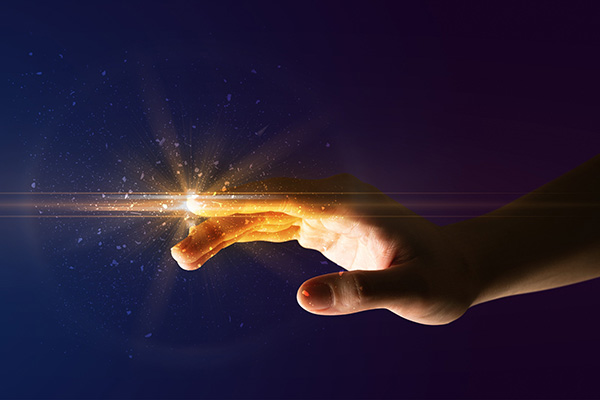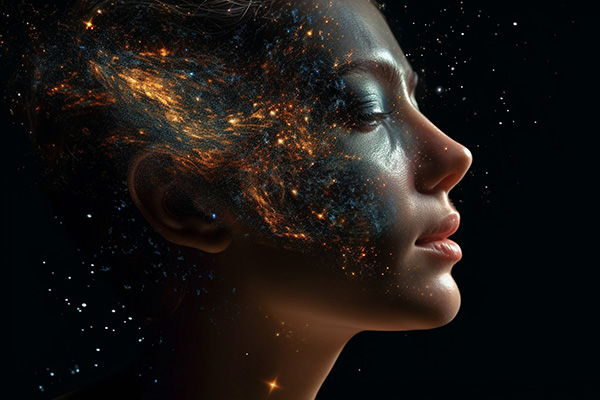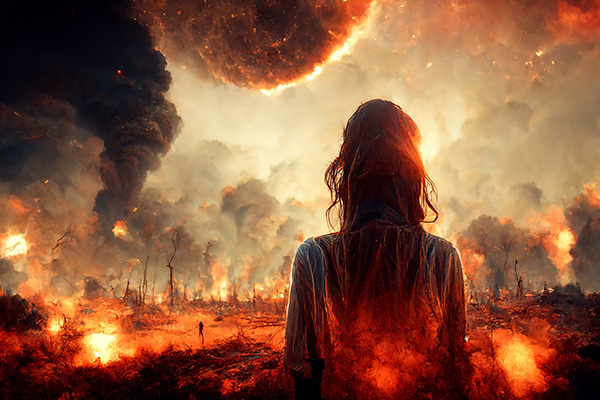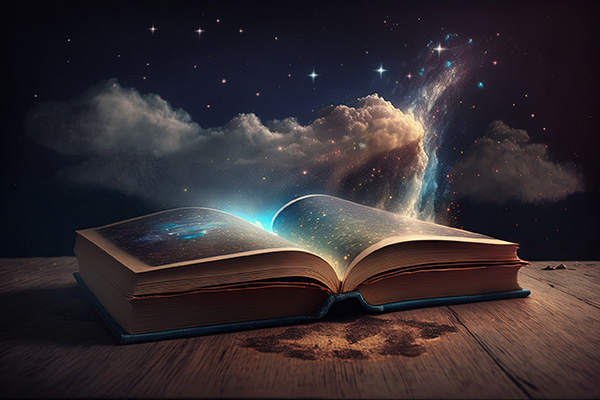Psychic Phenomena
The Mysterious Mischief Of Poltergeist Phenomena
 I have always been a sucker for scary ghost stories. In fact, the scarier, the better! Since my teenage years, I have sought out sensational tales of the supernatural for the sheer thrill of it.
I have always been a sucker for scary ghost stories. In fact, the scarier, the better! Since my teenage years, I have sought out sensational tales of the supernatural for the sheer thrill of it.
One particular story, that of “Pete the Poltergeist,” still stands out in my mind.
Britain was going through a recession in the 1980s, but despite the economic downturn, two self-employed men in Cardiff managed to run a successful lawnmower repair business called Mower Services out of one of their homes.
One day, one of the men thought he heard someone throwing stones at the door of the workshop, but when he went outside, he was surprised to find that no one was there. The rocks seemed to come from nowhere!
Later, the men noticed that their keys were hidden, and there was a very strange smell in a certain part of the workshop that suddenly became extremely cold. Later, they began to even find money and witnessed objects being thrown across the workshop floor – but they did not know what or by whom!
As a result of this unexplained activity, they decided to close the shop one night and conduct their own séance-style experiment. They placed their hands on a table, fingers touching, and asked the presence to throw a stone at them – which it did! Then one of the men asked for a pen and the entity threw one at them as well!
Who or what did this? The two men simply concluded that they had a ghost in their workshop that had become “like a member of the family” and decided to nickname it “Pete the Poltergeist.”
The Day The Angels Saved My Life
 I know now that my angels kept me from going to work that day for a reason. I have also learned since that I still had work to do that was important enough to keep me safe from injury or worse.
I know now that my angels kept me from going to work that day for a reason. I have also learned since that I still had work to do that was important enough to keep me safe from injury or worse.
I will never forget the day of the highway accident. It was September 3, 1999, and I had asked to be excused from work, which I never did. I was an office manager at a tool shop, working under a very arrogant accountant who had control issues with the employees.
I had worked there for several years without ever asking for extra time off, but he said no. He didn’t think I should have the day off because it was already a long weekend for us in Canada. The Labor Day holiday would have given me a four-day weekend instead of a three-day weekend.
He then threatened that I would lose my job if I took the day off because he didn’t approve of it and had no intention of changing his mind. But my gut was telling me very strongly that I simply could not go to work that day, I had to take it off. I didn’t know why at the time, I just knew I had to stay home.
So I did the only thing I could think of since my job security was in jeopardy – I went over his head to the owner and got the day off anyway! I later thanked the angels that I did that.
The accident happened about the same time I usually drive through the area on my way to work. I worked in Windsor, Ontario and lived in Valetta, which is almost an hour away. Every day I would get on the Queensline exit, east of Tilbury, and take the 401 to Oldcastle, where the 401 meets the highway. I have to admit I didn’t always drive the speed limit back then. I shudder to think what would have happened to me if I had driven my usual route to work that day!
Learning To Trust Your Intuition
 We are all born with an innate intuitive ability. However, many of us tend to shut down this innate aspect of our inner being at a young age.
We are all born with an innate intuitive ability. However, many of us tend to shut down this innate aspect of our inner being at a young age.
This can happen for a variety of reasons, but fear is often a major factor. Over time, many of us learn to view our intuition as our mind “playing tricks” or something to be wary of, or even as a source of discomfort that is just all in our imagination.
This misconception is unfortunate because intuition is not something to be feared or dismissed; rather, it is an integral part of our being that provides valuable insight and guidance.
Intuition is a fundamental part of living a full and complete life because it is a key part of our spiritual inner guidance. It cannot be lost or taken away. You are always in control of it and can choose to connect with it at any time.
The key to accessing and making the most of this inner wisdom is learning to trust its messages. But this can be challenging, especially when those messages are unclear or confusing. So, how do you cultivate greater trust in your intuition?
The first step in building trust with your intuition is to acknowledge and track the information it provides. Keep a journal or note-taking app handy and write down any intuitive insights you receive about your plans, goals, people, or situations. By recording these insights, you create a space for learning to understand how your intuition works and for validating your impressions over time.
The Mystical Practice Of Psychic Surgery
 The phenomenon of psychic surgery has always fascinated me. Although I have never personally witnessed such a procedure first hand, I did see footage of a psychic surgeon in action many years ago.
The phenomenon of psychic surgery has always fascinated me. Although I have never personally witnessed such a procedure first hand, I did see footage of a psychic surgeon in action many years ago.
Despite the poor quality of the movie, it seemed to me to be very real and certainly not a parlor trick, as many skeptics might suggest. The footage left a lasting impression and piqued my curiosity about a practice that operates on the edge of the mystical and the medical.
The film I saw was recorded by a friend who is very enthusiastic about psychic surgery. He had filmed the footage during a trip to the Philippines, where he observed the procedure firsthand.
He explained that psychic surgery is essentially the manipulation of energy and vibration. The practitioner is able to penetrate the patient’s skin with his bare hands using “polarity,” which is the balancing or manipulation of opposing energy forces.
In many spiritual and alternative healing practices, polarity is a term used to describe the dynamic interaction between different types of energy, often referred to as positive and negative energy, or yin and yang.
The idea is that everything in the universe, including the human body, operates on a balance of these opposing energies. When this balance is disturbed, disease or physical ailments can result.
In psychic surgery, practitioners use polarity to perform seemingly miraculous procedures with their bare hands. The idea is that by tapping into and manipulating these energies, they can create a state in which the physical body becomes malleable, allowing them to penetrate the skin without causing pain or bleeding. The procedure is performed without invasive surgery or the use of anesthesia.
What You Should Know About Psychic Ability
 Psychic ability is a complex phenomenon and can vary greatly from person to person.
Psychic ability is a complex phenomenon and can vary greatly from person to person.
Most psychics are born with their gifts, but these abilities often become stronger and more refined over time. This gradual development helps to ensure that psychics aren’t overwhelmed by the energy and information they receive.
Sometimes these gifts may also take a break or become less active for a while, only to come back when needed.
Psychic gifts come in many forms, just like the people who have them. No two psychics are exactly alike, and their abilities manifest in different ways. Some psychics may have visions or images of future events – this is called clairvoyance.
Others may be clairsentient, which means they can feel the emotions and energies of people, places, or objects. Some psychics are mediums who communicate with the spirit realm, connecting with deceased loved ones or other spirit beings.
No matter what type of ability a psychic has, these gifts are considered a blessing. But with these gifts also come a responsibility to use them wisely. Many psychics feel a strong desire to help others by offering guidance, insight and healing through their abilities.
However, it is important to remember that psychics don’t know everything. Their insights are often limited to what is revealed to them by spirit and the divine. Mostly a psychic will only receive the information most needed and appropriate for a specific person or situation at that moment in time. Continue reading
The Missed Opportunities Of Prophetic Predictions
 Psychics and mediums are mostly known only for giving personalized predictions and spiritual advice tailored to individual clients. People often come to us for help with personal issues such as relationships, career choices, and other life concerns.
Psychics and mediums are mostly known only for giving personalized predictions and spiritual advice tailored to individual clients. People often come to us for help with personal issues such as relationships, career choices, and other life concerns.
But there’s a bigger picture that doesn’t get as much attention: the role of some highly gifted psychics in making large-scale predictions that address collective challenges or foresee major events that affect everyone. These larger prophecies, such as warnings of natural disasters, economic crises, or global conflicts, are often unrecognized, overlooked, and even ridiculed.
Large-scale prophecies can have a big impact on the greater good if they were to be taken more seriously. If documented and acted upon, they can help society prepare for significant events and improve overall well-being.
In our modern world, the value of prophetic insights from today’s psychics and mediums is more relevant than ever. While prophecy may seem outdated compared to modern science and technology, these predictions can help us navigate the uncertainties and complexities of the future.
At their core, prophetic predictions are warning messages from the spirit realm, universal consciousness, the divine. They’re not random or whimsical; they’re meant to guide humanity by giving us glimpses into possible future scenarios. These visions are also not meant to interfere with our free will, but to alert us to possible outcomes so that we can take proactive steps to prevent or mitigate any negative effects.
